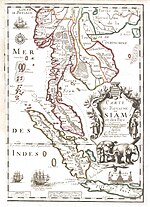Draft:Sri Kotrabun
Sri Kotrabun | |
|---|---|
| 8th–11th century | |
| Religion | Buddhism, Hinduism |
| Government | Monarchy |
| Historical era | 8th century-11th century |
• Established | 8th |
• Disestablished | 11th century |
| Today part of | Thailand, Laos |
| History of Thailand |
|---|
 |
|
|
Sri Kotrabun or Sikhottabong, Sri Gotapura (Thai: ศรีโคตรบูรณ์, โคตรบูรณ์, Lao: ສີໂຄດຕະບອງ)
History[edit]
Around the 1st century CE, several localized mini-states or fiefdoms began to develop in the middle Mekhong valley and were later influenced by the Indian-Brahmin through the coastline states which performed maritime trades with other states. Various kingdoms and fiefdoms emerged as a result, assimilating the cultures of the Cham and Mon peoples that previously resided in the region. These administrative spheres or mandalas were Indian-styled power centers, occupying the central Mekong Valley region. Later, trade, marriages, and rivalries between rulers further aided in the expansion of these mandalas.[1]
In the 8th century, Sri Kotrabun was the strongest of these early city-states and controlled trade throughout the Middle Mekong region. Its first capital was located at the mouth of the Sri Bangfai River, on the west bank of the Mekong, in the present-day Nakhon Phanom Province. However, Sri Kotrabun later relocated further westward to avoid the expansion of the Champa empire, another Indianized State on the coast of present-day Vietnam, founded in 192 CE.
The Mon, for example, brought Buddhism, Sanskrit, and many other Indian influences and art forms into the area. For instance, the Dvaravati-style art form, which is mainly religious, i.e. Buddhist, in nature. Later, various Dai-speaking peoples, predecessors to the modern-day Lao and Thai, along with ethnic Mon and Khmer groups, migrated across the Mekong River to settle in the Sri Kotrabun kingdom region, which reflected in the numerous minority groups still living in the area, with their diverse dialects and customs.
References[edit]
- ^ Hla, Nai Pan (1992). The Significant Role of the Mon Language and Culture in Southeast Asia (part 1). Tokyo, Japan: Institute for the Study of Cultures of Asia and Africa, Tokyo University of Foreign Studies. Retrieved 18 September 2013.
